Teaching and Learning in a Digital Age
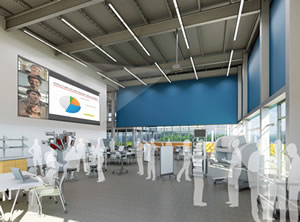
PHOTO COURTESY OF LEE HIGH SCHOOL/© DLR GROUP
The net generation — a cohort of young adults born between 1982 and 1991 — has arguably influenced the modern learning environment more than any other generation before it. Net Gens came into this world as masters of technology. They learned to use devices before they learned to walk and talk. And when they entered school, educators realized this tech-savvy contingent exhibited a unique method of learning, a style that was quite different than previous generations.
Districts and education designers keeping pace with tech-savvy students are collectively rethinking traditional school facility design. We’ve moved beyond the “classroom” as the space for learning and have adapted our designs to support more active and social learning. The common denominator found in every space is technology. Suites of varying shapes and sizes create environments where students can work digitally and socially. Advanced labs equipped with the latest amenities allow students to build contraptions and solve problems with their hands. Technology can be leveraged for more collaborative work. It also can stimulate critical thinking and encourage students to take ownership over their personalized learning path.
As a K-12 education designer, I want to incorporate fundamental design elements that will maintain relevance for years to come. Some of these features include flexibility and agility, an expansive technology infrastructure, connectivity, and interactive learning spaces.
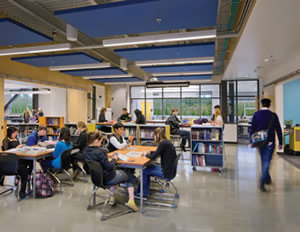
PHOTO COURTESY OF MARYSVILLE GETCHELL CAMPUS/ © CHRIS J ROBERTS PHOTOGRAPHY
Flexibility and agility
Rethinking instructional space makes way for multiple modalities of learning to occur. Flexibility and agility in schools allows for simple restructures to meet the evolving needs of students. In every scenario, technology is abundant and easily accessible throughout a facility. What we’ve found, as designers, is that creating these physical conditions requires us to critically rethink how a building gets put together at a level of infrastructure. This includes basic building systems (e.g. HVAC, plumbing, power), but also technology infrastructures, their accessibility to users, and their accessibility for updates over time. What we look for are opportunities to plan and design structure and systems to align with educators’ evolving models for how learning now happens as something active, mobile, and interactive.
What that looks like depends upon each school and its needs, but two examples are Marysville Getchell Campus in Marysville, Wash., and Lee High School in East Baton Rouge, La. At Marysville Getchell Campus, DLR Group’s design uses a “shell and core” concept. This solution draws most loadbearing structure and plumbing out to the exterior walls, with electrical and HVAC routed through floor and ceiling. Interior walls can be easily reconfigured as necessary over time to adapt to changes in educational program. Most importantly, technology is ubiquitous.
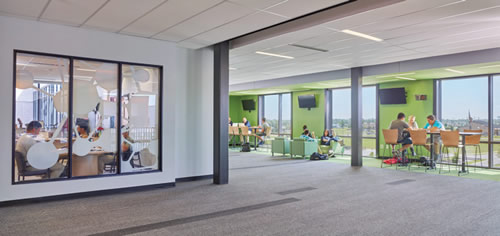
PHOTO COURTESY OF JOPLIN HIGH SCHOOL/ © ALISTAIR TUTTON PHOTOGRAPHY
Lee High School is a technology-rich and adaptable school that supports projectbased learning with flexible spaces that can be configured for a variety of uses. Three, 400-student academies deliver a personalized and customizable learning experience in the fields of Science, Technology, Engineering and Math (STEM), bio-medical, and digital arts. The facility is designed to allow students to apply what they learn in a classroom in a specialized laboratory within their academy.
Digital displays
School design should communicate the type of learning that is happening inside the facility. It does this by reflecting the nature of the students and how they approach learning with their educators. For Net Gens, that means shifting away from traditional constructs and objects and moving toward interactive and digital ones. For example, displaying student work throughout a school celebrates learning. That principle itself hasn’t changed. It celebrates the student who created it, and allows students to feel more connected and valued by their school. So as we move towards an online future, where much of student work will be done digitally, what does a student display look like?
Traditional media like canvas and paintbrush will remain relevant for many years, but we need to find the right balance that seamlessly integrates technology. The new Joplin (Mo.) High School successfully strikes this balance. The school’s technology backbone includes a wireless infrastructure and abundant power supply for the evolving tablet culture. Digital media is fully integrated throughout the school with the use of video boards, touch screens, kiosks and interactive displays. Rather than using print media, students and staff can create digital videos or motion graphics to promote ideas and events. These displays, coupled with a transparency throughout the facility, promote collaboration anywhere and everywhere in the facility.
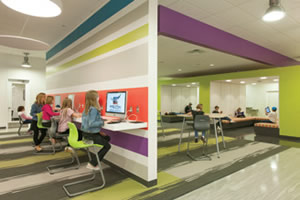
PHOTO COURTESY OF FALCON VIRTUAL ACADEMY/ © ED LACASSE PHOTOGRAPHY
24/7/365
Today’s students are connected 24/7/365, and this concept should extend into the learning circle. In the near future, school days may become more fluid and adjustable to meet a specific learning plan for students. Flexible school hours may replace the traditional 8 a.m. to 3 p.m. school day. In some Districts this shift to personalized instruction is happening already. Districts utilizing flipped classroom or online learning concepts allow student access to their lecture anywhere — in a coffee shop or at home. Students go to school to test, experiment, collaborate, and analyze information.
One example of the 24/7/365 model is Falcon Virtual Academy in Colorado Springs, Colo. The Academy is the centerpiece of Falcon School District 49’s focus on virtual learning, serving the needs of K-12 students following an online learning model for primarily home schooled students, working students, and transitional students. Students get the best of both worlds at this school: virtual and hands-on learning opportunities taught by certified teachers in a creative, engaging space. The technology allows teachers to use iPads and AppleTV’s for instruction and text messaging is common for communication with teachers. The robust network allows for multiple users without diminishing bandwith. Flexible, cozy furnishings and a technology rich environment are also attractive attributes for Board of Education meetings and other Community groups needing a space for meetings of all sizes.
Buildings can talk
Touchscreen access is a commonality now at home, such as the ability to easily change the temperature at home while we are away, lock doors remotely, or access a webcam on a phone to check on the dog or respond to an alert of unusual activity. This type of technology is also making its way into learning environment. And more than simple environmental controls, it uses building technology to provide real time feedback to occupants and serves as a learning tool.
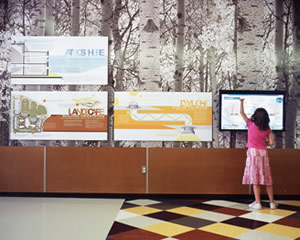
PHOTO COURTESY OF EVIE GARRETT DENNIS CAMPUS/© ED LACASSE PHOTOGRAPHY
Inside Evie Garrett Dennis E12 Campus in Denver, Colo., energy kiosks with interactive touch screens are positioned at the main entrance of each building to offer students, staff and visitors a glimpse into sustainable features at the campus. Touch screens offer multiple options. Individuals can view educational lessons depicting how heat recovery ventilation provides fresh air to breathe, or how the geothermal system works to efficiently heat and cool buildings. They can read about green strategies on campus, including green cleaning chemicals, recycled materials or stormwater management, and they can also view a LEED checklist that illustrates the design and construction process of securing a LEED certified facility. Students utilize these devices to monitor and compare energy performance across campus. A leader board ranks each building’s energy performance daily, weekly, monthly and yearly, to prompt friendly competition between academies while educating students about responsible energy consumption.
At Pioneer Middle School in DuPont, Wash., students and visitors see a green touchscreen immediately as they enter the school. A network of energy sensors throughout the building streams constant energy consumption data to the touchscreen display that is accessible by students, staff and visitors. A graphic readout of building resource consumption allows teachers to conduct hands-on coursework and experiments so students can learn about responsible energy use within the context of a building designed for maximum energy efficiency. Students also compare current energy use data against past history and standard school energy use to understand how the design of their new school positively impacts the environment.
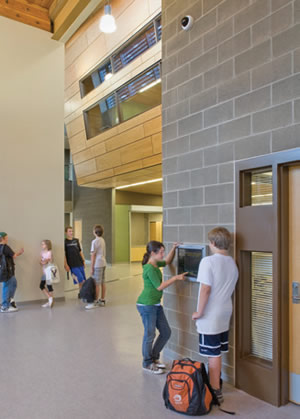
PHOTO COURTESY OF PIONEER MIDDLE SCHOOL/ © CHRIS J ROBERTS PHOTOGRAPHY
The connected library
As media continues the shift to online resources, we are seeing the traditional library repurposed or reconsidered as an active learning space and research commons. The space and available technology caters to varying types of active learning, including analysis, creation, debate and presentation.
A perfect example of the connected library is Allen Library Research Commons at the University of Washington. This facility enables University of Washington students to conduct collaborative research activities in a vibrant and technology-rich environment. DLR Group’s design uses FF&E selections to create distinct zones of activity within a large open space. The use of predominantly mobile systems allows the students to reorganize spaces on the fly to adapt to their specific needs in formal and informal research and presentation activities. Whether exploring concepts with fellow students on whiteboards, conducting online research, or communicating with people across the world to share ideas, users of the Research Commons are able to take full advantage of this space to fulfill their academic needs.
Upon opening, the Allen Library Research Commons saw immediate use from the campus community. Students embraced the interactive atmosphere, and a post occupancy analysis showed students were staying in the facility longer during each visit. Nearly 65 percent of all visits are for more than one hour, which is longer than visits to any other library facility on the University of Washington campus.
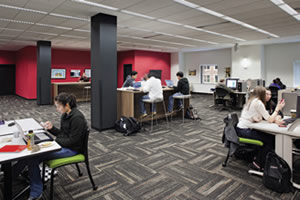
PHOTO COURTESY OF ALLEN LIBRARY RESEARCH COMMONS/© SAM VAN FLEET PHOTOGRAPHY
What’s next?
So what will the learning scene look like in 50 years? It’s difficult to predict the exact environment, but one thing’s certain — technology is here to stay. The type of technology learners will use in the future will become increasingly sophisticated and will be a driver of change in the learning process. Our role, as designers, is to create spaces that integrate current technology, adapt to future technology trends and provide students with the tools to become global leaders.
This article originally appeared in the issue of .